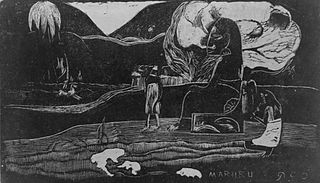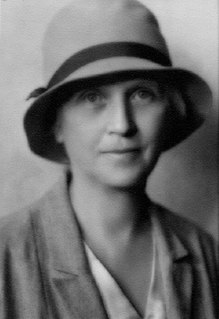Related Research Articles

The Polynesian narrative or Polynesian mythology encompasses the oral traditions of the people of Polynesia together with those of the scattered cultures known as the Polynesian outliers. Polynesians speak languages that descend from a language reconstructed as Proto-Polynesian - probably spoken in the Tonga - Samoa area around 1000 BC.

Hina is the name assigned to a number of Polynesian deities. The name Hina usually relates to a powerful female force who has dominion over a specific entity. Some variations of the name Hina include Sina, Hanaiakamalama, and Ina. Even within a single culture, Hina could refer to multiple goddesses and the distinction between the different identities are not always clear. In Hawaiian mythology, the name is usually paired with words which explain or identify the goddess and her power such as Hina-puku-iʻa (Hina-gathering-seafood) the goddess of fishermen, and Hina-ʻopu-hala-koʻa who gave birth to all reef life.

In Māori mythology, Tāne is the god of forests and of birds, and the son of Ranginui and Papatūanuku, the sky father and the earth mother, who used to lie in a tight embrace where their many children lived in the darkness between them.

Hine-nui-te-pō in Maori legends, is a goddess of night and she receives the spirits of humans when they die. She is the daughter of Tane Mahuta / Tane Tuturi and Hine-ahuone. It is believed among Maori that the colour red in the sky comes from her. Hine nui te Po Shepherds the Wairua/souls into the underworld to ready them for the next stage of their journey.
In the traditions of ancient Hawaiʻi, Kanaloa is a god symbolized by the squid or by the octopus, and is typically associated with Kāne. It is also the name of an extinct volcano in Hawaiʻi.

In Hawaiian mythology, Laka is the name of two different popular heroes from Polynesian mythology.. Lengthy legends of their exploits extend throughout the islands, and the kings of Tahiti and Hawaiʻi claimed them as their ancestors.

In Hawaiian mythology, Kamapuaʻa is a hog-man fertility superhuman associated with Lono, the god of agriculture. The son of Hina and Kahikiula, the chief of Oahu, Kamapuaʻa was particularly connected with the island of Maui.
In Hawaiian religion, the Kumulipo is the creation chant, first recorded by Westerners in the 18th century. It also includes a genealogy of the members of Hawaiian royalty and was created in honor of Kalaninuiamamao and passed down orally to his daughter Alapaiwahine.

In Hawaiian religion, Pele is the goddess of volcanoes and fire and the creator of the Hawaiian Islands. Often referred to as "Madame Pele" or "Tūtū Pele" as a sign of respect, she is a well-known deity within Hawaiian mythology and is notable for her contemporary presence and cultural influence as an enduring figure from ancient Hawaii. Epithets of the goddess include Pele-honua-mea and Ka wahine ʻai honua.
Pilikaʻaiea was Aliʻi Nui of Hawaiʻi. He was a sovereign king or chief, who deposed the indigenous chief, Kapawa.
In Hawaiian mythology, Laʻieikawai (Lāʻi.e.-i-ka-wai) and her twin sister Laʻielohelohe were princesses, and were born in Lāʻie, Oʻahu.
In Hawaiian mythology, Kapo is a goddess of fertility, sorcery and dark powers. Kapo is also known as Kapo-ʻula-kīnaʻu, where "the epithet ula-kinaʻu is used in allusion to the fact that her attire, red in color, is picked out with black spots. The name Kapo alone is the only by which she is usually known." "Kapo is said to have been born of Papa while she was living up Kalihi valley on Oahu with Wakea, her husband. Some say that she was born from the eyes of Papa. She is of high rank and able to assume many shapes at will." She is the mother of Laka, although some versions have them as the same goddess. She is the sister of Kāne Milohai, Kamohoaliʻi, Pele, Nāmaka and Hiʻiaka.

In Hawaiian religion, Māui is a culture hero and ancient chief who appears in several different genealogies. In the Kumulipo, he is the son of ʻAkalana and his wife Hina-a-ke-ahi (Hina). This couple has four sons, Māui-mua, Māui-waena, Māui-kiʻikiʻi, and Māui-a-kalana. Māui-a-kalana's wife is named Hinakealohaila, and his son is named Nanamaoa. Māui is one of the Kupua. His name is the same as that of the Hawaiian island Maui, although native tradition holds that it is not named for him directly, but instead named after the son of Hawaii's discoverer.
In Tahitian mythology, Vahieroa is a son of Tafa'i and his wife Hina, and is born at his father's house in the Tapahi hills of Mahina in north Tahiti. He weds Maemae-a-rohi, sister of the ruling chief Tumu-nui.

Martha Warren Beckwith was an American folklorist and ethnographer, appointed to the first chair in Folklore established in the U.S. She was born in Wellesley Heights, Massachusetts.
The House of Moana is a princely line of the Islands of Hawaii. The line begins with Moana kāne, the son of the former aliʻi nui of the island, Keākealani Kāne and is also the name of the ruler's granddaughter. Moana kāne and Moana Wahine's descendants include many, if not most of the monarchs from the House of Kamehameha. In the Hawaiian language "moana" means: "ocean". The word combines moe and ana and can also mean the act of prostrating one's self by leaning forward on one's hands and knees in the presence of a chief. Also meaning the act of worship. Ku-hai-moana is the most famous of the Hawaiian shark gods.

Vagina dentata describes a folk tale in which a woman's vagina is said to contain teeth, with the associated implication that sexual intercourse might result in injury, emasculation, or castration for the man involved. The topic of "vagina dentata" may also cover a rare medical condition affecting the vagina, in which case it is more accurately termed a vaginal dermoid cyst.

In Hawaiian mythology, Kū or Kūkaʻilimoku is one of the four great gods. The other three are Kanaloa, Kāne, and Lono. Feathered god images or ʻaumakua hulu manu are considered to represent Kū. Kū is worshiped under many names, including Kū-ka-ili-moku, the "Snatcher of Land". Kūkaʻilimoku rituals included human sacrifice, which was not part of the worship of other gods.
Kahiko-Lua-Mea is a god in Hawaiian mythology, who was once a chief on the Earth and lived in Olalowaia. He is mentioned in the chant Kumulipo and in the Chant of Kūaliʻi.
Rogo-Tumu-Here was an octopus demon from Tuamotu mythology. He attacked and swallowed Hina-Arau-Riki, the wife of Turi-A-Faumea, son of Tangaroa and Faumea, and was slain by the former males along with Tu-Nui-Ka-Rere.
References
- 1 2 3 4 Beckwith, Martha Warren (1976) [1st pub. 1940]. Hawaiian Mythology. University of Hawaii Press. ISBN 9780824805142.
- ↑ Cotterell, Arthur (1980). A Dictionary of World Mythology: 1St American Ed. Oxford University Press. ISBN 0192177478.
- ↑ Ross, Sonja Brigitte (1994). Die Vagina dentata in Mythos und Erzählung: Transkulturalität, Bedeutungsvielfalt und kontextuelle Einbindung eines Mythenmotivs (in German). Holos.
- ↑ Lederer, Wolfgang (1968). The fear of women . Grune & Stratton.
faumea.
- 1 2 Coulter, Charles Russell; Turner, Patricia (2013-07-04). Encyclopedia of Ancient Deities. Routledge. ISBN 9781135963972.
| | This article relating to a myth or legend from Oceania is a stub. You can help Wikipedia by expanding it. |